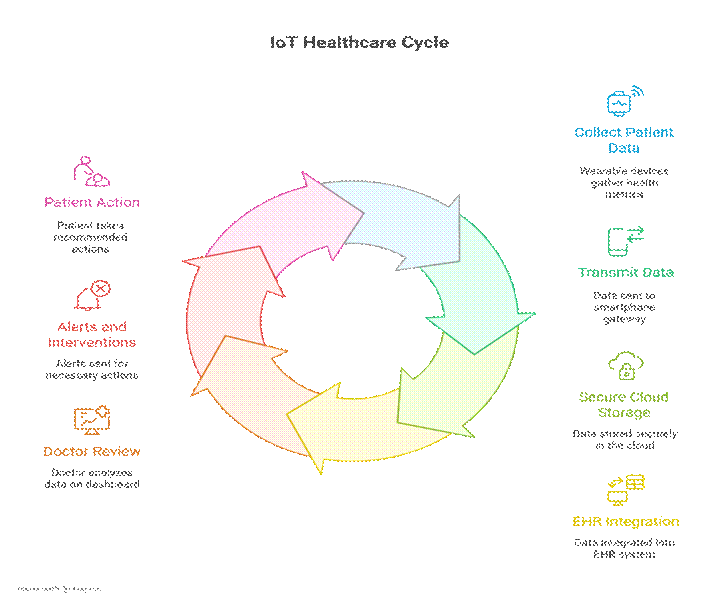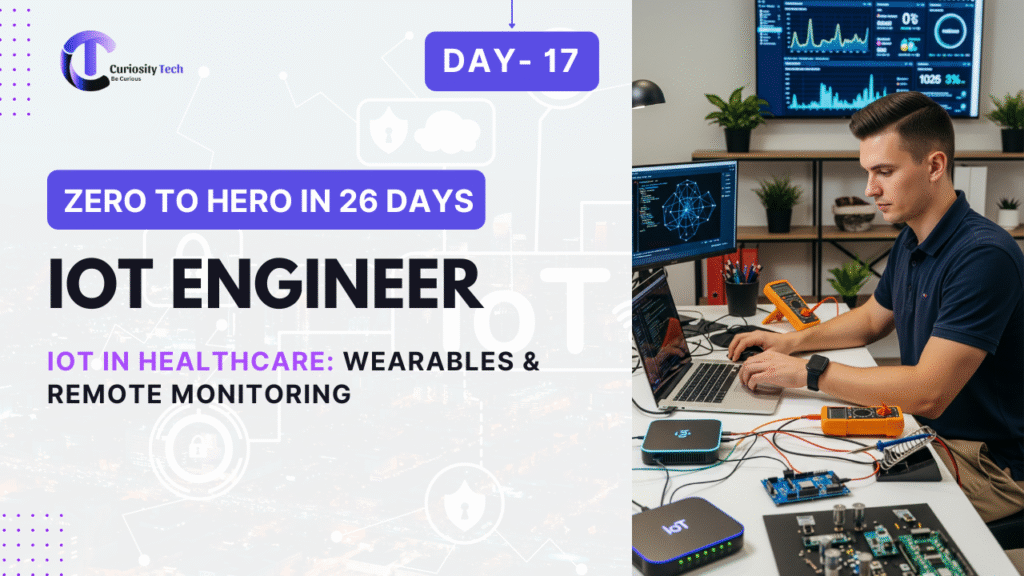Introduction – When Health Meets IoT
Healthcare is shifting from hospitals to homes, from reactive to proactive. In 2025, millions of patients worldwide wear IoT devices on their bodies — smartwatches, glucose monitors, ECG patches, blood pressure cuffs — that send continuous health updates to the cloud. Doctors no longer wait for critical incidents; they detect and prevent them in real-time.
At CuriosityTech.in Nagpur workshops, young engineers experiment with open APIs from wearables and learn how remote monitoring frameworks are built with security, reliability, and sensitivity to human health.
A Day in the Life – Patient Case Story
Meet Mrs. Anjali, 58 years old, living in Nagpur, diagnosed with mild heart arrhythmia and diabetes.
Morning – IoT Watch at Home
- She wakes up, her IoT smartwatch automatically syncs her overnight heart rate variability and SpO₂ levels to a cloud dashboard.
- Her physician receives an early morning summary via Azure IoT Hub integration with a hospital management system.
- Alert: Slight irregular heartbeats detected at 3 AM.
Afternoon – Continuous Glucose Monitor (CGM)
- A sensor patch on her arm tracks her glucose every 5 minutes.
- Data sent to mobile app → API to Google IoT Core + BigQuery.
- Real-time graphs alert her when glucose spikes after lunch. The system recommends short walk.
Evening – Remote Doctor Consultation
- A wearable blood pressure cuff transmits data over Bluetooth → smartphone → AWS IoT Core.
- Doctor reviews live data via a ThingsBoard dashboard.
- Intervention: Sends her an alert to increase water intake and rest.
This is the human face of healthcare IoT — data removes distance between patient, doctor, and outcome.
Technical Components of Healthcare IoT
- Wearable Devices:
- Smartwatches (Samsung Watch, Apple Watch, Fitbit).
- Glucose monitors (Dexcom G6, Abbott FreeStyle Libre).
- ECG and heart patches (Zio patch, AI-based patches).
- IoT rehab devices (motion trackers for physiotherapy).
- Connectivity:
- BLE (Bluetooth Low Energy) → phone as gateway.
- Wi-Fi for direct hospital link (in premium devices).
- NB-IoT/cellular wearables (critical patients).
- Data Handling:
- Edge preprocessing (on-device AI for arrhythmia detection).
- Secure cloud (AWS HealthLake, Azure Health Data, Google Cloud Healthcare API).
- Visualization: FHIR-compliant dashboards in clinics/hospital apps.
IoT Healthcare Architecture Flow

Use Cases of IoT in Healthcare
1. Chronic Disease Management
- Continuous glucose monitoring for diabetes.
- Blood pressure wearables for hypertension.
2. Emergency Alerts
- Fall-detection smartbands for elderly.
- Cardiac event detection notifying emergency centers.
3. Post-Surgery Remote Care
- IoT patches measure wound healing via temperature/pressure sensors.
- Remote clinics monitor progress, reducing hospital stays.
4. Mental Health IoT
- Stress detection via heart-rate variability sensors.
- Sleep pattern tracking correlated with depression monitoring apps.
Clinical Standards & Regulations
Healthcare IoT must comply with strict standards:
- HIPAA (USA), GDPR (Europe) – Data privacy.
- ISO 13485 & IEC 60601 – Medical device certification.
- FHIR (Fast Healthcare Interoperability Resources): Ensures health data portability.
At CuriosityTech training, engineers simulate security compliance frameworks by encrypting patient IoT data streams and integrating with FHIR APIs.
Case Studies
Case 1 – Diabetes IoT Monitoring
- Deployment: 200 patients in Maharashtra monitored with IoT glucose patches.
- Outcome: Patients reduced ER visits by 30% due to early alerts.
- ROI: Cost of patches justified by massive savings in hospital costs.
Case 2 – Cardiac Remote Monitoring
- Deployment: Cardiac IoT patches integrated with Azure IoT Hub in Nagpur hospital.
- Incident: 3 patients’ arrhythmia detected early; emergency response saved lives.
- Lesson: Near real-time alerts differentiated IoT from traditional monitoring.
ROI Analysis Table – IoT in Healthcare
| Use Case | Cost/Patient (₹/Year) | Savings/Patient (₹/Year) | Net Impact |
| Glucose IoT Monitor | ₹28,000 | ₹60,000 hospital savings | 2.1x ROI |
| IoT Cardiac Patch | ₹45,000 | Lives saved + insurance premium cut | Priceless + ROI |
| Elderly Fall Detection | ₹12,000 | Reduced home nurse hours ₹20,000 | 1.6x ROI |
Challenges
- Battery Life: Wearables need multi-day use.
- Data Security: Critical patient data often hacked if endpoints unsecured.
- Integration Gap: Devices differ in protocol (BLE, Wi-Fi, proprietary).
- Digital Literacy: Elderly patients often need training to use apps.
- Regulatory Clearances: IoT wearables considered “medical devices”, require approval.
Emerging Trends (2025)
- AI on Wearables (Edge Intelligence): Detecting arrhythmias or hypoglycemia locally without cloud.
- Voice-integrated IoT Health Assistants.
- Interoperability Protocols: Universal FHIR for sharing across hospitals.
- Nano-Sensors: Implanted sensors measuring blood chemistry continuously.
CuriosityTech’s Role in Healthcare IoT
At CuriosityTech.in Nagpur, IoT healthcare projects are central to labs:
- Students built a portable IoT ECG patch connected via ESP32 BLE to a cloud dashboard.
- Another batch prototyped smart inhalers tracking asthma patient puff counts to avoid misuse.
- Hackathons encouraged hospital partnerships for innovation in affordable rural IoT healthcare solutions.
Such projects demonstrate that IoT healthcare isn’t distant — it’s a reality accessible for both startups and rural clinics.
Conclusion
IoT healthcare wearables are rewriting how medicine is delivered. Patients no longer live in uncertainty; doctors no longer rely only on 6-month lab checkups; families no longer guess when to rush to ER. Sensors create continuous care.
For IoT engineers, healthcare is a sector of responsibility. It requires not only technical mastery but also ethical design, strict security compliance, and empathy-driven innovation. With innovators trained and guided at platforms like CuriosityTech.in Nagpur, the IoT-enabled future of medicine is already here: personal, preventive, and predictive.


